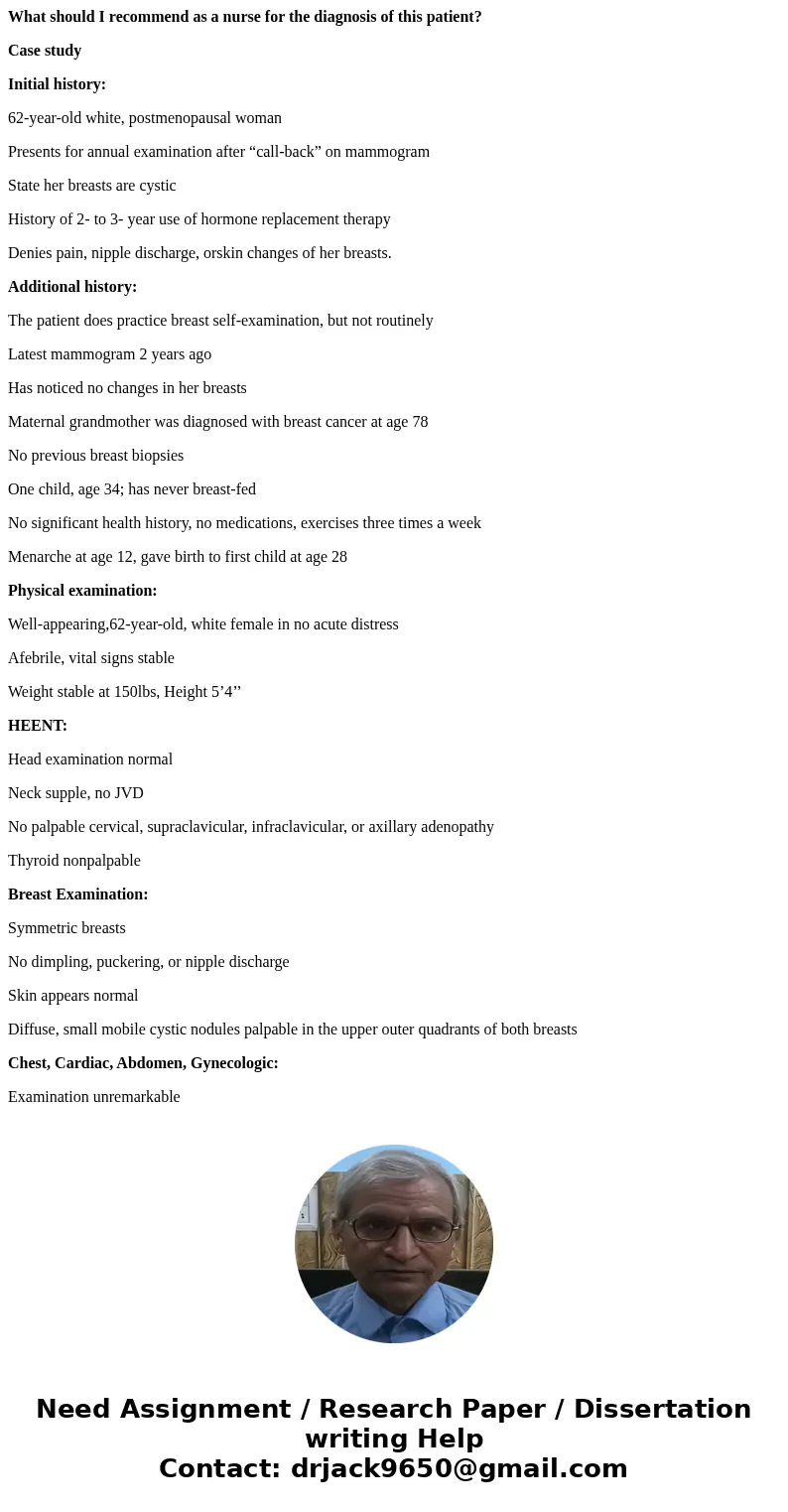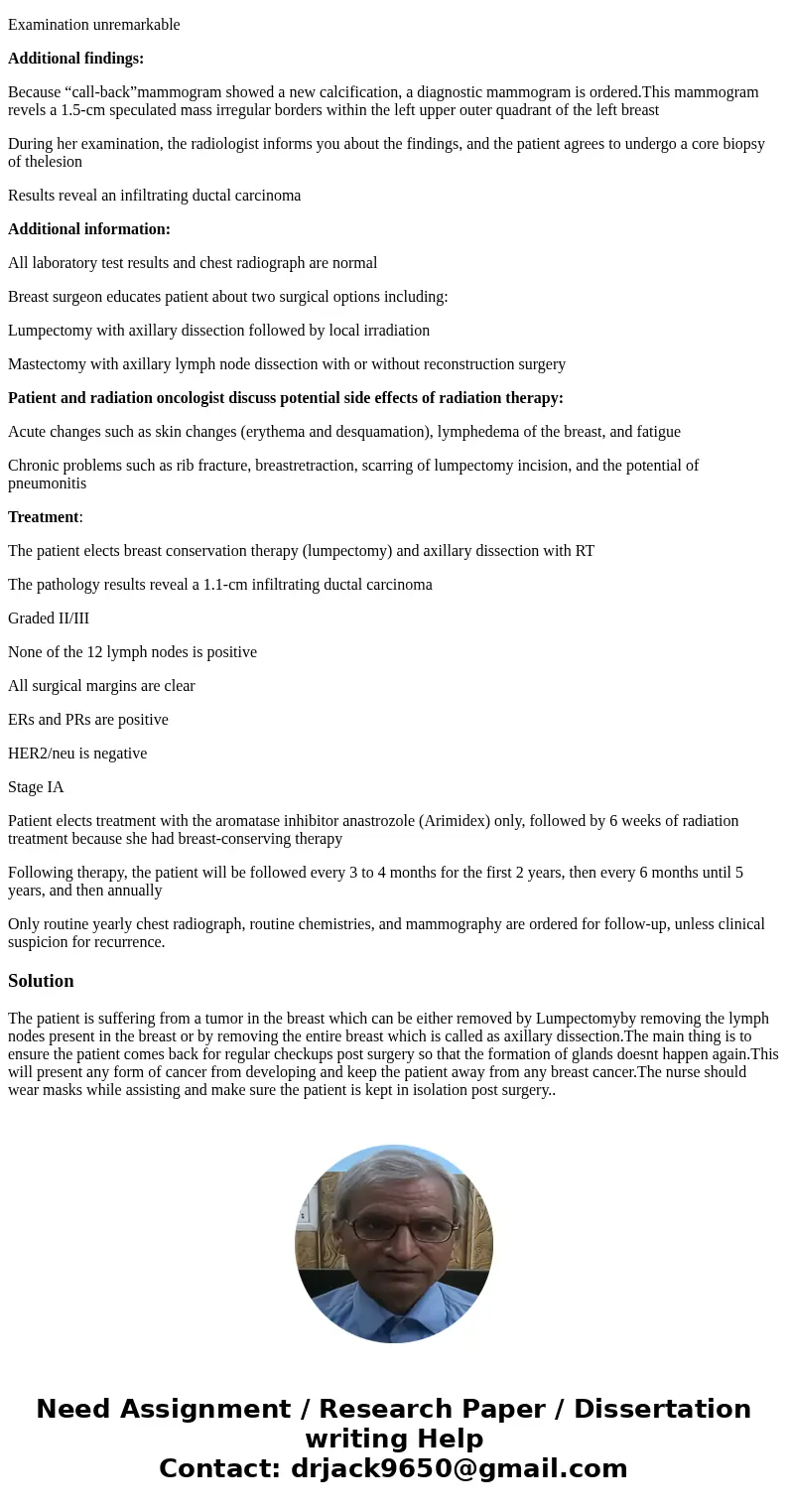What should I recommend as a nurse for the diagnosis of this
What should I recommend as a nurse for the diagnosis of this patient?
Case study
Initial history:
62-year-old white, postmenopausal woman
Presents for annual examination after “call-back” on mammogram
State her breasts are cystic
History of 2- to 3- year use of hormone replacement therapy
Denies pain, nipple discharge, orskin changes of her breasts.
Additional history:
The patient does practice breast self-examination, but not routinely
Latest mammogram 2 years ago
Has noticed no changes in her breasts
Maternal grandmother was diagnosed with breast cancer at age 78
No previous breast biopsies
One child, age 34; has never breast-fed
No significant health history, no medications, exercises three times a week
Menarche at age 12, gave birth to first child at age 28
Physical examination:
Well-appearing,62-year-old, white female in no acute distress
Afebrile, vital signs stable
Weight stable at 150lbs, Height 5’4’’
HEENT:
Head examination normal
Neck supple, no JVD
No palpable cervical, supraclavicular, infraclavicular, or axillary adenopathy
Thyroid nonpalpable
Breast Examination:
Symmetric breasts
No dimpling, puckering, or nipple discharge
Skin appears normal
Diffuse, small mobile cystic nodules palpable in the upper outer quadrants of both breasts
Chest, Cardiac, Abdomen, Gynecologic:
Examination unremarkable
Additional findings:
Because “call-back”mammogram showed a new calcification, a diagnostic mammogram is ordered.This mammogram revels a 1.5-cm speculated mass irregular borders within the left upper outer quadrant of the left breast
During her examination, the radiologist informs you about the findings, and the patient agrees to undergo a core biopsy of thelesion
Results reveal an infiltrating ductal carcinoma
Additional information:
All laboratory test results and chest radiograph are normal
Breast surgeon educates patient about two surgical options including:
Lumpectomy with axillary dissection followed by local irradiation
Mastectomy with axillary lymph node dissection with or without reconstruction surgery
Patient and radiation oncologist discuss potential side effects of radiation therapy:
Acute changes such as skin changes (erythema and desquamation), lymphedema of the breast, and fatigue
Chronic problems such as rib fracture, breastretraction, scarring of lumpectomy incision, and the potential of pneumonitis
Treatment:
The patient elects breast conservation therapy (lumpectomy) and axillary dissection with RT
The pathology results reveal a 1.1-cm infiltrating ductal carcinoma
Graded II/III
None of the 12 lymph nodes is positive
All surgical margins are clear
ERs and PRs are positive
HER2/neu is negative
Stage IA
Patient elects treatment with the aromatase inhibitor anastrozole (Arimidex) only, followed by 6 weeks of radiation treatment because she had breast-conserving therapy
Following therapy, the patient will be followed every 3 to 4 months for the first 2 years, then every 6 months until 5 years, and then annually
Only routine yearly chest radiograph, routine chemistries, and mammography are ordered for follow-up, unless clinical suspicion for recurrence.
Solution
The patient is suffering from a tumor in the breast which can be either removed by Lumpectomyby removing the lymph nodes present in the breast or by removing the entire breast which is called as axillary dissection.The main thing is to ensure the patient comes back for regular checkups post surgery so that the formation of glands doesnt happen again.This will present any form of cancer from developing and keep the patient away from any breast cancer.The nurse should wear masks while assisting and make sure the patient is kept in isolation post surgery..


 Homework Sourse
Homework Sourse